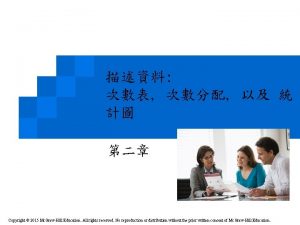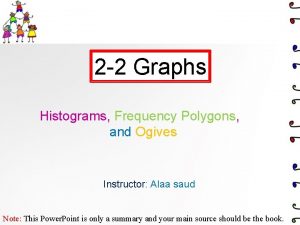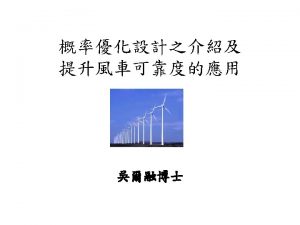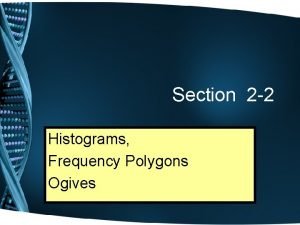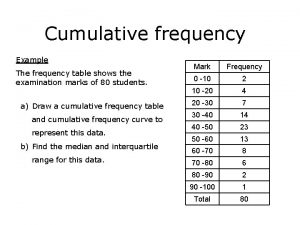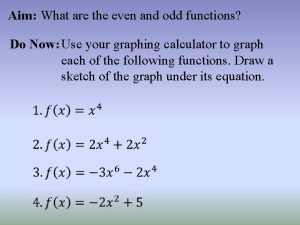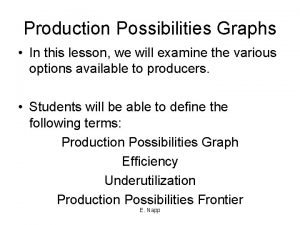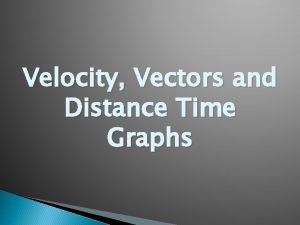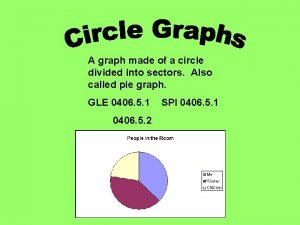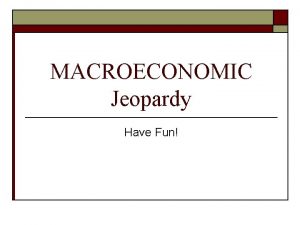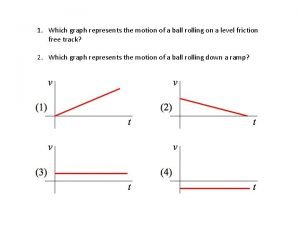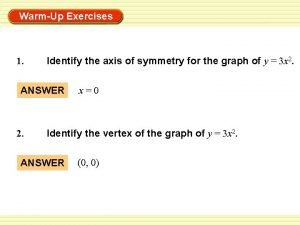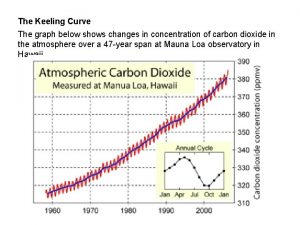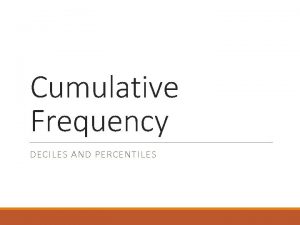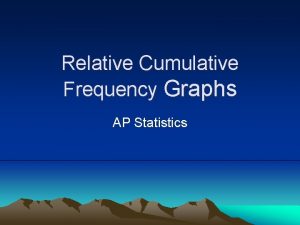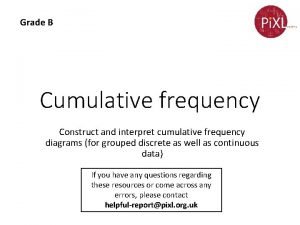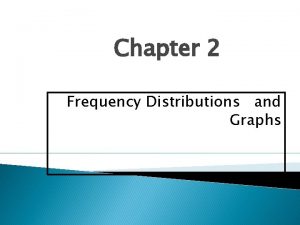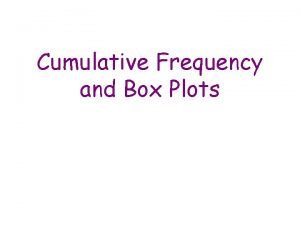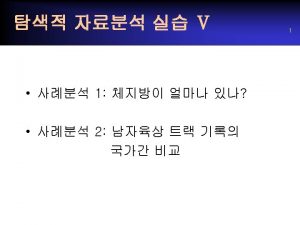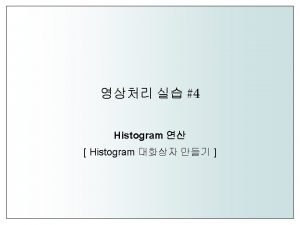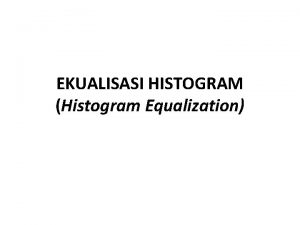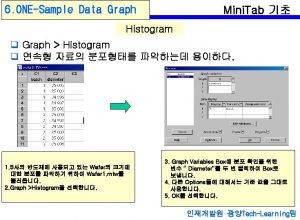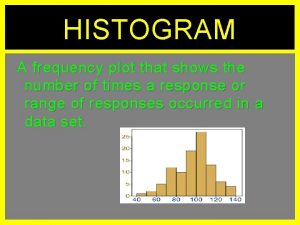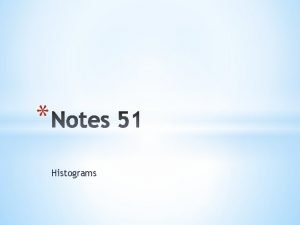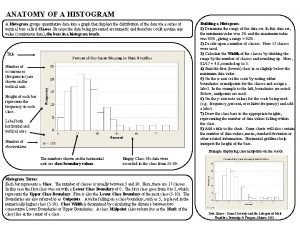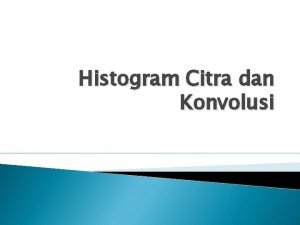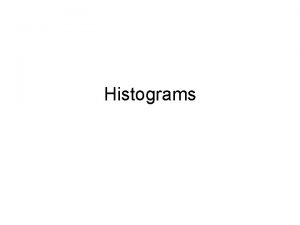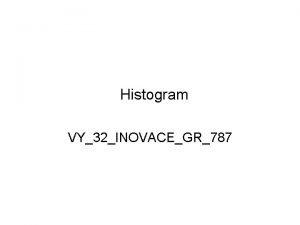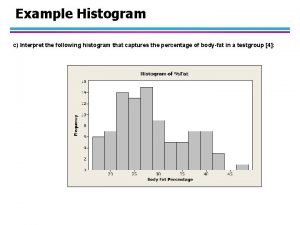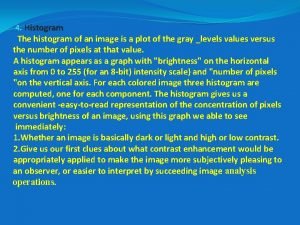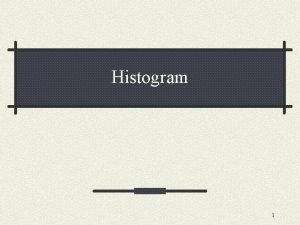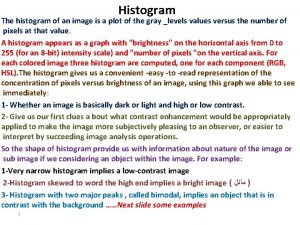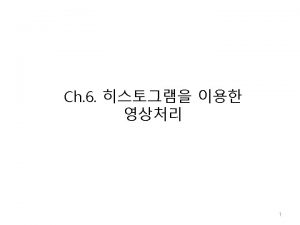Histogram Histogram is a graph that shows frequency








































- Slides: 40

Histogram • Histogram is a graph that shows frequency of anything. Histograms usually have bars that represent frequency of occuring of data. • Histogram has two axis: x and y. • The x axis contains the event whose frequency we count. • The y axis contains frequency.

Histogram • Example of a typical histogram.

Histogram • Consider some students with their marks.

Image histogram • Image histogram shows frequency of pixel intensity values. • x axis shows the gray level intensities • y axis shows the frequency of intensities.

Image histogram x axis – shows the range of pixel values. For 8 bpp image, we have 256 levels of gray shades

Brightness • Brightness is a relative term. It can be defined as the amount of energy output by a source of light relative to the source we are comparing to. Image on the right is brighter than image on the left.

Brightness • Brightness can be easily increased or decreased by simple addition or subtraction to the image matrix

Contrast • The contrast of the image can be defined as the difference between maximum pixel intensity and minimum pixel intensity. • Max. int. = 0, Min. int. =0 • Contrast = 0– 0=0 • Max. int. = 100, Min. int. =100 • Contrast = 100– 100=0

Image transformations • Transformation is a function. It maps one set to another set after performing some operations. • Digital Image Processing system performs the transformation.

Image transformation • Consider the equation g(x, y)=T(f(x, y)) f(x, y) – input image, transformation is applied to this image. g(x, y) – output image (processed image). T is a transformation function.

Image transformation • The transformation can be also represented as s=T(r) r – pixel value of the input image f(x, y) s – pixel value of the output image g(x, y)

Image transformation Original image

Histogram sliding • Brightness is changed by shifting the histogram to left or right. +50

Histogram sliding - 30

Histogram stretching • Contrast can be increased using: 1. Histogram stretching 2. Histogram equalization • Contrast is the difference between maximum and minimum pixel intensity. Contrast = 225.

Increasing the contrast f(x, y) Low contrast image g(x, y) High contrast image

Contrast stretching Before Contrast = 225 After Contrast = 240

Contrast stretching • This formula doesn’t work always. If there is 1 pixel with intensity 255: Contrast stretching has no effect!!!

Introduction to probability • PMF and CDF are both related to probability. They will be used in Histogram Equalization. • PMF – Probability Mass Function. • It gives the probability of each number in the data set (frequency of each element).

Probability – PMF Calculating PMF from image matrix PMF Image matrix 1 7 0 1 6 2 2 1 7 3 5 5 0 5 4 7 6 3 6 5 3 7 4 0 2 2/25 1 4 4/25 2 3 3/25 3 3 3/25 4 2 2/25 5 4 4/25 6 3 3/25 7 4 4/25

Probability – PMF Calculating PMF from histogram Frequency of gray level values for an 8 bits per pixel image. Not monotonically increasing function

Probability – CDF • CDF – Cumulative Distributed Function • Cumulative sum of values calculated by PMF

Probability – CDF • CDF will be calculated using the histogram • CDF makes the PDF grow monotonically • Monotonical growth is necessary for histogram equalization.

Histogram equalization • Histogram equalization is used for enhancing the contrast of the images. • The first two steps are calculating the PDF and CDF. • All pixel values of the image will be equalized.

Histogram equalization • Image with its histogram

Histogram equalization Small image (values)

Histogram equalization Image detail Frequency of pixel values

Histogram equalization

Histogram equalization • min = 52 • max = 154 cdfmin is the minimum non-zero value of the cumulative distribution function (in this case 1), M × N gives the image's number of pixels (for the example above 64, where M is width and N the height) and L is the number of grey levels used (in most cases, like this one, 256).

Histogram equalization New min. value = 0, old min. value 52 New max. value = 255, old max. value 154 Original Equalized

Histogram equalization An unequalized image Corresponding histogram (red) and cumulative histogram (black) The same image after histogram equalization Corresponding histogram (red) and cumulative histogram (black)

Negative transformation Negative Original s = (L – 1) – r

Concept of convolution Black box

Concept of convolution g(x, y) = h(x, y) * f(x, y) mask convolved with an image g(x, y) = f(x, y) * h(x, y) image convolved with mask The convolution operator (*) is commutative, h(x, y) is the mask or filter.

Convolution mask • Mask is a matrix, usually of size 1 x 1, 3 x 3, 5 x 5 or 7 x 7 (odd number). • Convolution steps: – Flip the mask horizontally and vertically – Slide the mask onto the image – Multiply the corresponding elements and add them – Repeat this until all image values are calculated

Convolution example • Mask: • After flipping the mask:

Convolution example • Image matrix • Place the mask over each image element. Multiply the corresponding elements and add them

Convolution example • Red – mask, black – image • First pixel: = (5*2) + (4*4) + (2*8) + (1*10) = 10 + 16 + 10 = 52 Convolution can achieve blurring, edge detection, sharpening, noise reduction, etc

Concept of mask • A mask is a filter. Concept of masking is a concept of spatial filtering. • Sample mask • Filtering is convolving a mask with an image by moving the center of the mask over each image pixel.

Filters • Filters are used for: - blurring - noise reduction - image sharpening - edge detection
 Con hãy đưa tay khi thấy người vấp ngã
Con hãy đưa tay khi thấy người vấp ngã Thơ thất ngôn tứ tuyệt đường luật
Thơ thất ngôn tứ tuyệt đường luật Tôn thất thuyết là ai
Tôn thất thuyết là ai Phân độ lown
Phân độ lown Walmart thất bại ở nhật
Walmart thất bại ở nhật Gây tê cơ vuông thắt lưng
Gây tê cơ vuông thắt lưng Block xoang nhĩ độ 2
Block xoang nhĩ độ 2 Tìm vết của mặt phẳng
Tìm vết của mặt phẳng Sau thất bại ở hồ điển triệt
Sau thất bại ở hồ điển triệt Thể thơ truyền thống
Thể thơ truyền thống Histogram and frequency polygon
Histogram and frequency polygon Histogram and frequency polygon examples
Histogram and frequency polygon examples Relative frequency histogram generator
Relative frequency histogram generator Frequency polygon superimposed on a histogram
Frequency polygon superimposed on a histogram When god shows up he shows off
When god shows up he shows off Formula for cumulative frequency
Formula for cumulative frequency What are joint relative frequencies
What are joint relative frequencies Vmax=aw
Vmax=aw What is joint relative frequency
What is joint relative frequency Relative frequency bar chart
Relative frequency bar chart Frequency vs relative frequency
Frequency vs relative frequency What is a marginal frequency
What is a marginal frequency Average of sine wave
Average of sine wave Shape 65
Shape 65 This graph shows a portion of an odd function
This graph shows a portion of an odd function Underutilization on a graph
Underutilization on a graph The accompanying graph shows marie's distance from home
The accompanying graph shows marie's distance from home A type of graph that shows a circle divided into sections
A type of graph that shows a circle divided into sections The graph shows changes in the velocity of a racing car
The graph shows changes in the velocity of a racing car The graph below shows the value of a $100 deposited
The graph below shows the value of a $100 deposited This graph shows a ball rolling from a to g
This graph shows a ball rolling from a to g The scatter graph shows the maximum temperature
The scatter graph shows the maximum temperature Equation of axis of symmetry
Equation of axis of symmetry The graph shows data from the light colored soil enclosure
The graph shows data from the light colored soil enclosure The graph below shows atmospheric carbon dioxide
The graph below shows atmospheric carbon dioxide Scatter graph exam questions
Scatter graph exam questions Interdecile range formula
Interdecile range formula Cumulative relative frequency graph worksheet
Cumulative relative frequency graph worksheet How to interpret cumulative frequency
How to interpret cumulative frequency Comulative frequency graph
Comulative frequency graph Cumulative frequency box plots
Cumulative frequency box plots










